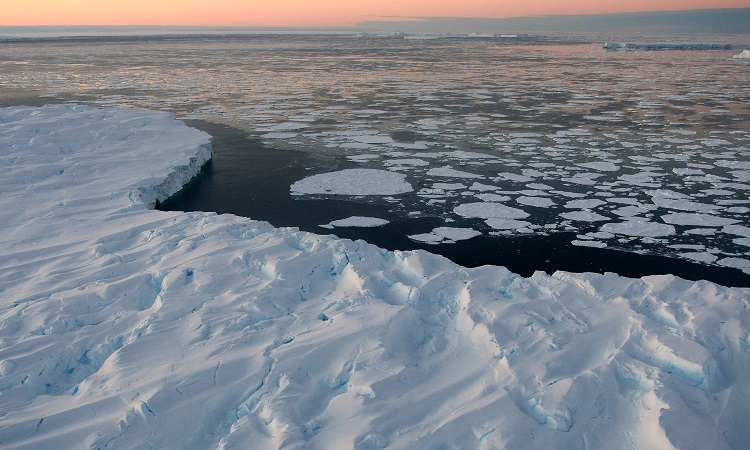Denmark: Ice sheet movement can be used as an indication to show sea level rise
Using extensive satellite measurements, researchers from the GEUS and the University of Copenhagen's Niels Bohr Institute have conducted a study that shows how movements of the ice sheet are linked with meltwater flow beneath the ice. Read further on Dynamite News:

Copenhagen: The Greenland ice sheet is enormous, making up nearly half of all fresh water in the northern hemisphere. But rising temperatures on Earth are causing it to melt -- and the world's oceans to rise. As such, the ice sheet's movements are closely monitored.
Using extensive satellite measurements, researchers from the Geological Survey of Denmark and Greenland (GEUS) and the University of Copenhagen's Niels Bohr Institute have conducted a study that shows how movements of the ice sheet appear to be closely linked with meltwater flow beneath the ice.
Using artificial intelligence, the researchers analysed ice movements that they can now divide into four categories based on movement patterns. According to the researchers behind the study, this information has been missing from our understanding of why the velocity of ice at the same site can change over time, which is an important piece of knowledge for making more precise climate models for, among other things, sea level rise.
"With the help of large amounts of satellite data and artificial intelligence, we can identify and map general seasonal fluctuations over large parts of the ice sheet's edge. Not just for one year, but for fluctuations over a number of years as well. Thus, our study provides an indirect look at processes beneath the ice and the connection with meltwater on a large scale. This connection is very important to understand in relation to the warming climate of the future, in which the amount of meltwater will increase," explains Anne Munck Solgaard, Senior Researcher at GEUS and lead author of the study, now published in Geophysical Research Letters.
Tunnels beneath the ice
Also Read |
Srikanth, Prannoy progress into Indonesia Open quarters
As meltwater from the surface reaches the bottom of the ice, it flows primarily towards the edge of the ice sheet through melted channels. The researchers have found that the design of these channels, also known as subglacial drainage pathways, affects the movement of the ice above. If the channels, which act as a kind of drainage system, are poor at diverting water away, the pressure at the bottom rises and reduces friction between the ice and bottom. This in turn causes the ice to move faster towards the ocean. And vice versa, if the drainage system is effective, the ice moves more slowly.
According to Anne Munck Solgaard, the drainage system is not a fixed array of pipes or channels of a specific size, but rather, pathways that develop during the melt season. They do this because, while meltwater can melt drainage systems larger, the ice flow works to close systems. As such, the drainage system can alternate between being efficient and inefficient.
"This results in four variations in the velocity of ice that we've discovered at various locations across the ice sheet. For example, the velocity can slow in the middle of the melting season, when meltwater is plentiful because the drainage system suddenly becomes efficient. Or the system remains inefficient and under high pressure. So, the velocity accords with the amount of meltwater," says the Senior Researcher.
Thus, the researchers have been able to see where on the ice sheet ice moves, in one way or another, throughout the year. In doing so, they can gain insight into what is happening beneath the ice and keep an eye on how it changes from year to year. "Our results provide a better understanding of how the ice sheet reacts to warmer temperatures and more meltwater, which can help us develop future climate models," explains Dina Rapp, PhD student and co-author of the study.
Huge amounts of data demand artificial intelligence
Also Read |
Sports fraternity hails Srikanth on maiden Denmark Open title win
The researchers used artificial intelligence to detect and separate movement patterns in many thousands of measurements, which very quickly become unmanageable for human analysis. According to Professor Christine Hvidberg of the Niels Bohr Institute, the study's co-author, intelligent computing power is becoming increasingly necessary.
"In recent years, the amount of freely available satellite data has exploded. It comes from ESA's Sentinel satellites and America's Landsat. The data allows us to map the speed of ice in high resolution, both temporally and spatially. It's great, but it also makes it completely impossible to gain a complete overview of the ice's movements and patterns by manually looking through the time series. Here, artificial intelligence and heaps of computing power help us see previously undiscovered patterns and connections," she says.
Since 2016, continuous measurements from ESA's Sentinel-1 satellites have been used to calculate the movement of the ice sheet under the Programme for Monitoring of the Greenland Ice Sheet (PROMICE). (ANI)
 Dynamite News
Dynamite News 